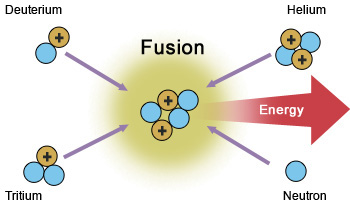ENERGY
Fusion Energy
Fusion power is the power generated by nuclear fusion reactions at the extremely high pressures and temperatures. In this kind of reaction, two light atomic nuclei (e.g. deuterium, 2H and tritium, 3H from hydrogen) fuse together to form a heavier nucleus and in doing so, release a large amount of energy. Most design studies for fusion power plants involve using the fusion reactions to create heat, which is then used to operate a steam turbine and drives generators for electricity. That is similar to most coal, oil and gas-fired power stations as well as fission-driven nuclear power stations.
Nuclear fusion reactions of deuterium and tritium

Unlike burning of coal or other fossil fuels, fusion produces only helium, a gas that is already in abundance in the atmosphere and will not contribute to global warming. No dangerous by-products such as nuclear waste is generated. The fuel for fusion reactions, i.e. deuterium (2H) and tritium (3H) from hydrogen in water, are virtually inexhaustible, making it an attractive option as a future energy source by the middle of this century. International collaboration is currently underway.